Table of Contents
Few technologies have captured the imagination, inspired fear, or changed the world quite like artificial intelligence.
Despite its role in early 20th-century fiction, AI has been part of the professional conversation for barely 70 years. AI was first studied at a Dartmouth College conference in 1956. Since then, it’s ridden waves of optimism, disappointment, and rediscovery. The 1960’s saw gains in machine translation and analysis. But AI underwent a “winter” from the 1970s through the early ‘90s.
The first descriptions of AI made it seem fit for only laboratory use.
Researchers shelved their work largely because of the problem of “combinatorial explosion.” A U.K. professor who first described the AI concept worried that too many variables would make it useless outside of lab settings. In the early ‘70s, groups like the U.S. Defense Advanced Research Projects Agency pulled funding. Research failures had become the norm.
Interest in AI grew during the 1990s and early 2000’s. Processing power and data volumes increased. At the same time, data sets grew massively. Algorithms gained more “meat” on which to train. Advances in game theory and data modeling led to new approaches.
AI is here — knowledge gaps are, too.
Today, best-in-class infrastructures can support 100,000 or more computers. Two-and-a-half quintillion bytes of data are now generated every day. Globally, private firms are spending tens of billions of dollars per year researching and improving AI initiatives. In fact, 2018’s investment amount is more than 50 percent larger than last year’s alone. Now, 2023 is set to see even more adoption of AI.
Add it all up, and AI seems ready for a leap forward unlike any seen in its history. But, after slow decades followed by speedy discoveries, few outside the field feel they truly understand it. A recent Dell Technologies report found that 67 percent of leaders said their companies were struggling to implement AI. A similar two out of three consumers don’t even realize they’re using it, according to a HubSpot survey.
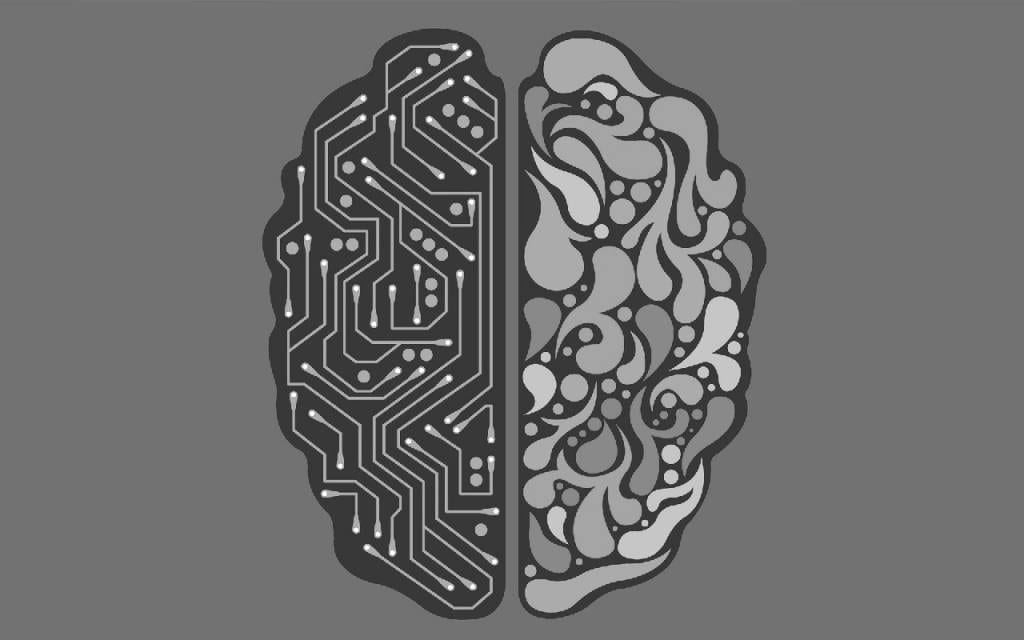

To arm company leaders with the know-how they need, this guide will:
- Explain the most common applications of AI.
- Explore the business benefits of investing in Artificial Intelligence.
- Describe how AI is used for customer service.
- Examine AI’s ability to augment sales and marketing.
- Consider how machine learning can simplify human resources.
- Suggest ways AI can enhance productivity.
- Answer common questions and concerns about workplace AI.
- Tease out present and future trends in AI.
This guide won’t get into the weeds of algorithmic development. But it should equip businesspeople, marketers, and consumers alike with a deeper understanding of what AI is all about. It will also show them what AI can do today and the workplace challenges it can create. Lastly, it will predict how AI might evolve tomorrow.
What is AI? A look at the landscape.


Contrary to how it’s portrayed in the media, AI isn’t a single, all-powerful tool. It’s actually a family of technologies with a variety of applications.
All AI systems developed to date belong to a category known as “narrow” or “weak” AI. Narrow AI tools are non-sentient and focused on a single task. They might answer questions or playing chess. General AI, sometimes known as “strong” AI, refers to a machine that can apply its skills to any problem put before it.
Today’s AI technologies may be single-use, but they have serious business potential. In 2023, the most common applications of AI include:
1. Automation.
In short, automation describes a process or procedure that’s done without human help. Automation can take many forms. Automation is why a household thermostat triggers the heating system when the temperature drops. It leads an oil pump to tweak downhole pressure according to the amount of oil flowing upward. In business, this means that AI can take over many time-consuming tasks, including scheduling meetings, responding to emails, and even answering customer questions through the use of chatbots.
2. Computer vision.
Computer vision has been adopted by banks, security firms, social media companies, and more. It’s concerned with how computers interpret digital images and video. Most computer vision tools make or suggest decisions based on a symbolic summary of large data sets. Subcategories of computer vision include event detection, object recognition, motion analysis, and image reconstruction. For businesses, AI can speed and improve decision-making, assist with response times, and deliver deeper business insights.
3. Diagnosis.
Diagnostic AI plays the two-fold role of investigator and quality controller. Often, it borrows from the field of computer vision. These tools need to make observations and check whether a human’s or a machine’s conclusion is correct. Unsurprisingly, this technology is used by factories, mechanics, and more industries in the field. But, one of its most promising uses of AI so far is in medicine. Using neural networks, AI systems have detected diseases like cancer and heart disease. Some are even more accurate than human doctors.
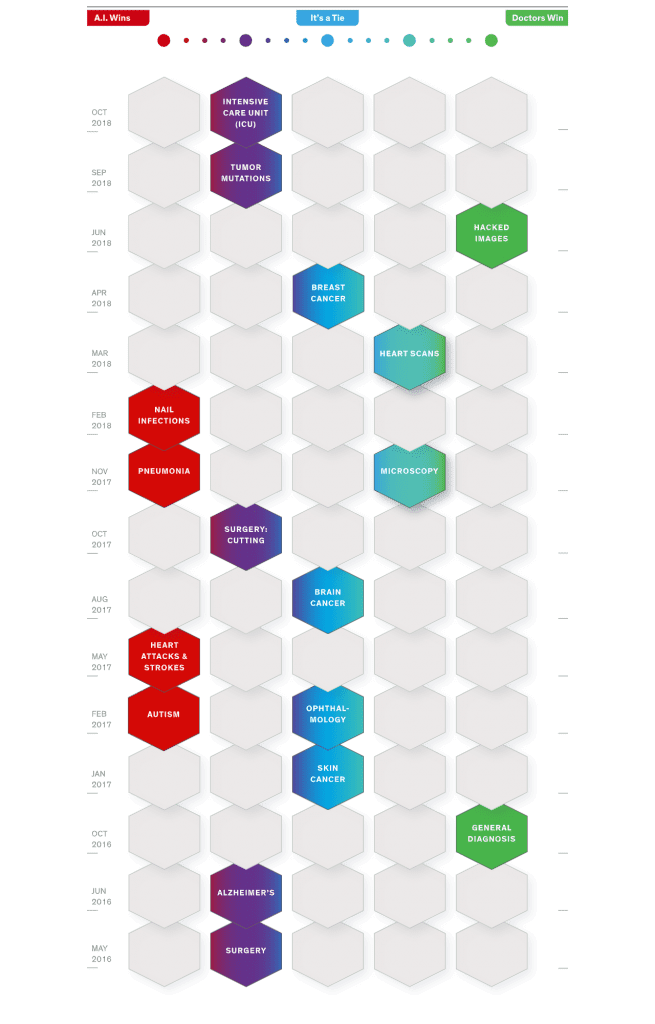

AI tools can detect some ailments better than human physicians can. Diagnostic AI can also check for product defects and proper assembly.
4. Knowledge management.
One of the most broadly useful types of AI technology so far is known as knowledge management. This category uses technology to create, share, and curate information. Whether they know it or not, most businesspeople already use this application of AI. They open their email to find spam messages shuffled, for instance. Other popular use cases include image retrieval, data mining, and entry resolution. For businesses, this type of AI assistance can improve how a company develops its strategy and how it develops customer experiences.s
5. Machine learning.
Machine learning may be the business world’s favorite AI application. It’s the method behind predictive analytics. Researchers trust the AI information to find patterns present in large data sets in a scalable manner. Security experts use these predictive patterns to detect credit card fraud. Insurers estimate claims with it. Marketers turn to this big data for social media analysis.
Machine learning’s most popular subfield is deep learning. These deep learning models learn through data representations rather than set algorithms. Compared to traditional machine learning, deep models can work with less structured data. They require fewer or no human-provided parameters.
In practice, this means deep models can analyze images and non-number data. Non-number data handles information so large that it has to be shown within symbols. This data is ideal for drug discovery, speech analysis, and prediction of customer lifetime value.
6. Robotics.
Robotics borrow from the other forms of AI mentioned here, as well as mechanical and electrical engineering. There are household devices like Roombas and drones to driverless cars. These cars “see” the environment around them. They check their own observations, categorize inputs, and adjust their decision-making according to data.
Generally, intelligent robots are nowhere near a reality, robotics plays a key role in areas, ranging from defense and transportation to medicine. Not every business will have a use for every variety of AI. But there’s a reason or, rather many reasons why, business leaders are investing in AI.
Why business leaders love AI.


Before considering the ways in which companies can use machine learning, it’s worth understanding why they’d want to. There are three reasons why 80 percent of enterprises companies are betting on AI in 2023 and beyond:
1. Build a better customer experience.
Already, two-thirds of marketers say their companies compete on the basis of the customer experience. By 2023, 81 percent of them expect to do so.
What sort of experiences are customers looking for, exactly?
In a word, customers are looking for personalization. They want one-to-one communications on their chosen channels. Businesses are looking to provide answers to customer inquiries about customizable products and at the time of their choosing. If that sounds like a tall order, it is.
How will companies provide these expectations?
The best answer at present is that the expectations will be filled through data and automation. Data insights are a primary tool for enhancing the customer’s experience. However, CX data is messy and customers are unpredictable. There are neither hard rules for building experiences nor clear success criteria for marketers to follow.
Along the way, AI will collect, organize, and manage customer data. AI will use a scaleability factor to tailor marketing materials. All of this information will be provided by the learning from past communications. In effect, AI can provide the multichannel experience people are looking for and do it quickly so that customers can immediately enjoy it.
2. Saves time.
Americans’ working hours have been increasing for decades. Professionals, like executives and engineers, put in the most time of any working group. Fifty-four percent of workers told pollster YouGov that they’ve begun answering work emails and phone calls at times when they’re not scheduled to be working.
At least in part, the problem is that American consumers expect 24/7 service. More than four in 10 consumers expect brands to respond within an hour of their online complaint. When it comes to sales or marketing questions, 82 percent expect a “now” response.
Without AI, it’s difficult to see how firms can give their employees some sort of work-life balance.
The known importance of work-life balance is rising proportionate to the customers’ expectations. The automation of easy tasks and use of communication tools like chatbots will be key to the ability for businesses to provide all that is required for both employee and customer demands.


According to IBM, AI will significantly change how companies craft their customer experiences. It also found, however, that few executives have a strategy in place for doing so.
3. Cut costs and boost profits.
Executives are under pressure to cut costs. According to an Accenture survey of 700 senior executives, 82 percent say they want to reduce expenses to invest in growth. Just 23 percent, however, say their company effectively drops business activities that don’t add value.
Fortunately, AI powers recommendation tools for cutting costs. A Forbes analysis also found it could save the average Fortune 500 company $4.7 million per year via automation.
But the big story isn’t what AI can do within any one company. It’s what AI will do across the entire economy.
A second Accenture study claims that through 2035, AI will grow industries by an average of 1.7 percent per year. The greatest winners will be IT and communication, at 4.8 percent; manufacturing, at 4.4 percent; and financial services, at 4.3 percent.
Where will all that growth come from? AI promises to streamline everything from car maintenance to medical operations to portfolio management. Let’s look first at one place every company can use AI to cut costs, save time, and improve its CX: customer service.
Three ways AI makes customer service smarter in 2023


Last year alone, businesses lost $75 billion because of shoddy customer service. Believe it or not, that’s nearly 20 percent more than companies lost the year before, according to a NewVoiceMedia report.
Consumers’ customer service expectations are rising. The good news is that companies can use Artificial Intelligence to improve their CX. So far, a few opportunities stand out:
1. Tag-team messaging.
When American, South Korean, Indian, and Singaporean consumers have something to say to a business, they turn to messaging. Across the wider world, a Twilio study claims, messaging is a top-three channel.
Unfortunately, Twilio also found that less than half of global companies have the systems they need to support customer messaging. Scalable messaging requires software, not to mention gobs of customer support agents to respond to messengers. At least, it did until recently.
AI-infused helpers known as chatbots are making it easier for businesses to sort and answer customer messages.
True, messaging bots can’t entirely take the weight off a customer service team. IBM found they can cut costs by some 30 percent, however. Chatbots can tackle roughly 80 percent of customers’ questions and route the rest to human agents. Additionally, chatbots have been good at cutting customer service costs. A study, Gartner predicts says that chatbot will tackle 85 percent of customer interactions by 2023.
2. Analyze calls and guide interactions.
AI may not be able to hold freeform conversations with customers quite yet, but it can provide call support in a surprising number of ways. Companies like Cogito, for example, offer speech analysis tools that use machine learning and natural language processing to predict customer satisfaction and improve agent performance.
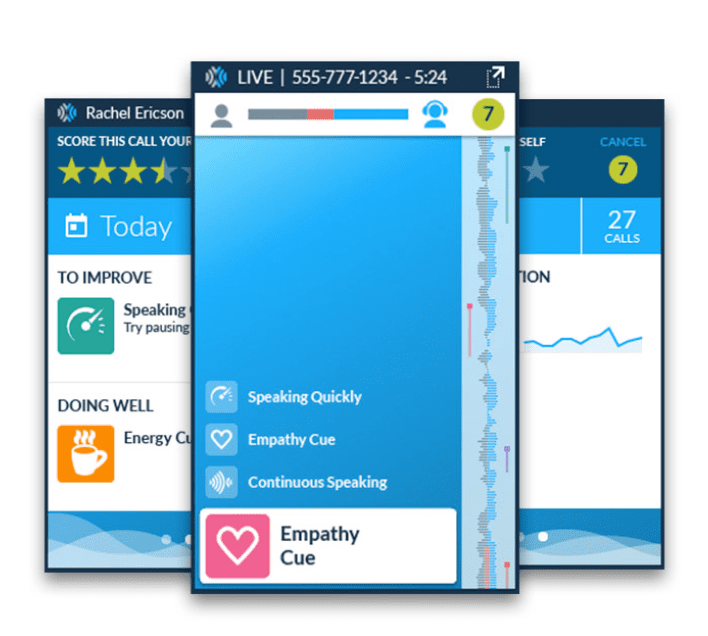

Cogito helps customer support agents know when to express empathy or slow their speech. Other AI tools can engage users directly and analyze prior calls.
At insurer MetLife, Cogito gives service people helpful nudges.
First, it “reads” the caller’s voice. Say it hears anger when someone calls in about a customer’s death. It then displays a heart icon to tell the agent to speak soothingly. If the AI detects sadness in a caller’s voice, Cogito shows a coffee-cup icon. In this way, the agent knows to add energy to his or her voice. Cogito also uses cross-call analysis. It signals to agents when they’re speaking faster than normal or spending longer than they typically do with a caller.
Bulk call analysis isn’t the bread and butter of Cogito. It is, however, at Tethr. Tethr makes call databases searchable. It then delivers insights it pulls from them to companies’ CRM systems. With those insights, it spots agent behaviors and phrases that align with higher customer satisfaction and success. Tethr claims that a Fortune-listed tech company reduced on-site service calls by 12 percent with this tool. An airline used Tethr to grow bookings by 22 percent.
3. Triage inquiries and customer tickets.
Especially useful at larger firms, service people don’t just speak directly with customers. These service persons also route service requests and emails to the correct individual or department. But what happens when teams and customers grow? It becomes less and less efficient to have someone sitting there reading every customer email.
The time savings is when the AI has simply done the deciding of who should tackle tasks and is delegating these. An actual person takes exponential amounts of time for the same system.
Don’t just throw more agents at this problem. Instead, turn to automated systems like Jatana. Jatana first reviews old tickets to learn each agent’s strengths. Then, it tags customer inquiries. Tags, for example, include “tech support” or “manager needed.” Jatana delivers the ticket to the associate it deems best able to resolve it.
This system claims to have helped smartwatch maker XPLORA drop its average handling time by 30 percent. In a separate case study, it describes a kitchen tool company that used Jatana to cut its first reply time by half.
AI may never entirely replace humans in customer service.
But there’s a reason why companies like Uber, Alibaba, and Lexus use AI to support their customer service teams: Customers prefer it. A joint report by Genesys and the Massachusetts Institute of Technology found that 91 percent of firms with global brand recognition use AI to improve their CX. Just 42 percent of their peers could say the same.
In other words, consumers want brands to adopt bots. They’re rewarding companies for it in ways that go beyond satisfaction scores. The reason: everyone is busy and this saves time.
6 Tasks AI can tackle for marketing and sales.


Algorithms that respond to the needs of existing customers are just one side of the equation. AI programs can also find and nurture leads. To do so, they can assist salespeople and marketers in a surprising number of ways:
1. Segment leads and customers.
Marketers have known for years that segmenting messaging makes it more effective. According to Mailchimp, segmented campaigns outperform their non-divided peers in almost every metric. The email marketing platform found that categorized campaigns achieved 14 percent more opens. Additionally, there were 101 percent more clicks, five percent fewer bounces, four percent fewer abuse reports, and nine percent fewer “unsubscribe” actions.
Marketers have also known for years, however, that segmentation is time-consuming.
How can marketers save time? Turn to AI tools like Dynamic Yield. The tool groups customers reported higher satisfaction according to the customers personal, opinion, and purchasing profiles. Dynamic Yield, which got $77 million in venture funding between its birth in 2013 and August 2018, can sort fields by dozens of different attributes. No wonder it’s used by firms with diverse clientele like IKEA, HelloFresh, and Stitch Fix.
2. Engage and qualify leads.
Until recently, lead qualification, like segmentation, was tedious, and error-prone work. At firms that find qualified leads manually, they’ve found that sales development representatives spend up to 75 percent of their time chasing unqualified leads. As a result, they miss out on up to 71 percent of leads.
As they have for segmentation, AI tools are streamlining lead qualification and outreach.
Conversica, in particular, is gaining attention for its automated sales assistant. Conversica can contact, qualify, and even follow up with leads. It claims that more than one-third of all leads respond to automated outreach across the 1,200 companies it serves.
One of Conversica’s greatest wins was with CenturyLink.
The telecom generates thousands of leads per month from the firms it services. CenturyLink didn’t want to hire dozens of reps to comb through them. Instead, it initiated a Conversica pilot. Since launching the program with four people, it’s since grown to 40 or more.
Conversica’s AI assistant, Angie, is amazing. She sends personalized messages to leads, analyzes their responses, assesses priorities, and then sends leads to salespeople. In CenturyLink’s pilot, Angie understood 99 percent of all responses she received, handing off just one percent to her manager.
3. Power product recommendations.
Personalized product suggestions are the secret sauce of e-commerce sites. Salesforce’s “Personalization in Shopping” report found that such recommendations drive just seven percent of clicks — but 26 percent of revenue.
Why such a spread? Because personalization is powerful.
Salesforce discovered that shoppers who click recommendations were about twice as likely to return. Orders that included a recommended item were roughly 10 percent more valuable than others.
Fortunately, brands no longer need to build their own recommendation engines. Amazon has begun giving away the AI behind its own product recommendations. By open-sourcing its DSSTNE model, Amazon is allowing any company or researcher to repurpose it for themselves.
Firms looking for plug-and-play tools have options as well. One of the most popular, Recolize, even delivers curated blog content. Recolize, which promises to increase users’ revenue by up to 20 percent, blends blog and product suggestions. Plus, it integrates with WordPress, Magento, Shopify, and more.
4. Turn data into written narratives.
Writing is one area marketers long thought AI wouldn’t touch. But a firm that got its start creating recaps of baseball games has taken on the challenge. Using natural language generation, Narrative Science’s Quill platform is helping clients like Deloitte, Mastercard, and the U.S. government create content at scale.
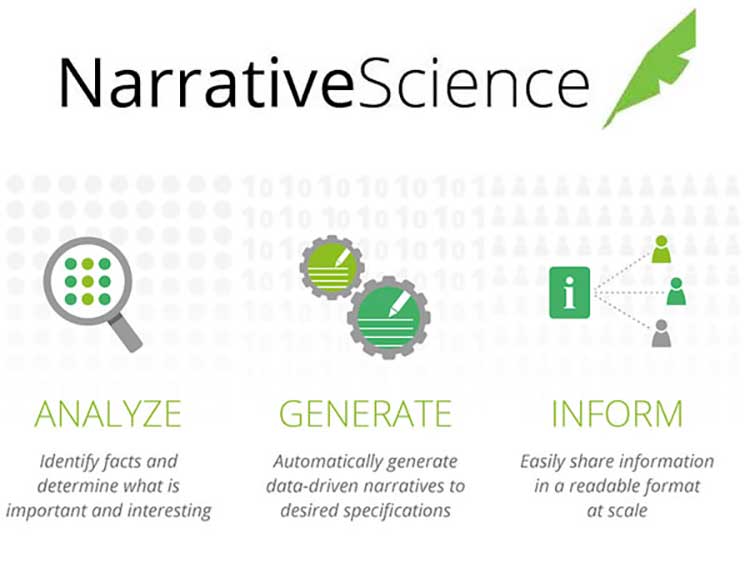

Narrative Science’s content generation tool finds pertinent data, crafts a narrative around it, and makes it easy to share. AI writing tools work best with figure-heavy stories.
Admittedly, some Quill stories lack the verve of human writing. Most of its data-based content, though, reads like content written by real people.
Forbes Magazine, for example, uses Quill to create profiles on companies whose stock prices are outperforming expectations. USAA, meanwhile, trusts this AI to craft articles that provide financial advice to its members.
Narrative Science argues that Quill is good for more than data-driven storytelling. Quill can draft and maintain product descriptions. It can also read analytics reports and provide commentary on the performance of certain investments.
5. Predict customer actions.
Customers are nothing if not unpredictable — or so salespeople and marketers have always thought. After a number of predictive analytics platforms posted less-than-stellar results, South Africa’s Xineoh decided to show companies just how smart AI predictions could be.
Using deep learning, Xineoh does more than just suggest products to shoppers. It spots business opportunities according to inventory, suggests price changes by reviewing spending patterns, and predicts customer churn. Plus, it recommends marketing channels and plans outreach to optimize customer lifetime value.
In the near future, expect analytics systems to become so accurate that they can initiate post-sale activities prior to purchase. Both Facebook and Amazon are working on anticipatory shipping tools. Soon, online retailers will ship products before a customer places an order.
6. Optimize pricing structure.
Historically, variable pricing has only been found in industries where supply is tight. Airlines charge more for seats on flights they expect to be full. Hotels do the same for rooms booked during weekends and holidays. But, thanks to AI, a whole range of companies are starting to proactively tweak their prices to maximize profits.
Houston-based startup Wise Athena works with consumer packaged goods companies to boost their margins from three to 12 percent per year. How does Wise Athena optimize promotion and pricing structures? By using a deep model that selects the data sets it deems most relevant to customer behavior. It updates its models monthly, optimizing rates and inventory with up to 98 percent accuracy.
The insurance industry, too, is getting in on the game.
Using both machine learning and computer vision, Bay Area startup Cape Analytics is helping insurers evaluate risks. It considers variables like roof condition, tree cover, and building layout. Cape Analytics is particularly popular among clients who insure properties in the southeastern U.S. Hurricane damage to a given property depends heavily on the building’s materials and roof condition.
AI has quite the track record of improving companies customer interactions. But, forget sales, marketing, and customer service for a moment. Does AI have a part to play in workplaces? Can it actually improve the ways companies recruit, interact with, and engage their teams?
AI can automate HR’s most tedious tasks.


Human resources may sound like a “humans only” department. At many companies, it still is. According to an Oracle study, just six percent of HR staff are actively deploying AI solutions. Overall, 24 percent of employees are doing so.
Believe it or not, the opportunities to optimize HR using AI may exceed those of any other business function.
1. Streamline recruiting.
Recruiters know how mind-numbing it can be to comb through thousands of résumés to staff a single position. Skipping over a solid applicant is easy to do. Mistaking a smooth talker for a qualified candidate happens, too. Add it all up, and it’s no wonder the average cost per hire tops $4,000.
Russian startup, Stafory, however, thinks it has a solution: Robot Vera.
Robot Vera helps companies like IKEA and PepsiCo reduce recruiting costs by as much as a third. The tool eliminates the bottom 90 percent of candidates before humans get involved. Before passing the rest on to real recruiters, Robot Vera conducts phone and video interviews. She gathers basic information from applicants and gauges their emotions.
What about technical recruiting? For that, firms are turning to AI startup Pomato.
Unfortunately, Pomato can’t conduct its own interviews. It does, however, use a skill-profiling feature to assesses candidates’ abilities across different design models and programming styles. Pomato then delivers top candidates to human recruiters with a list of suggested skills tests and interview questions.
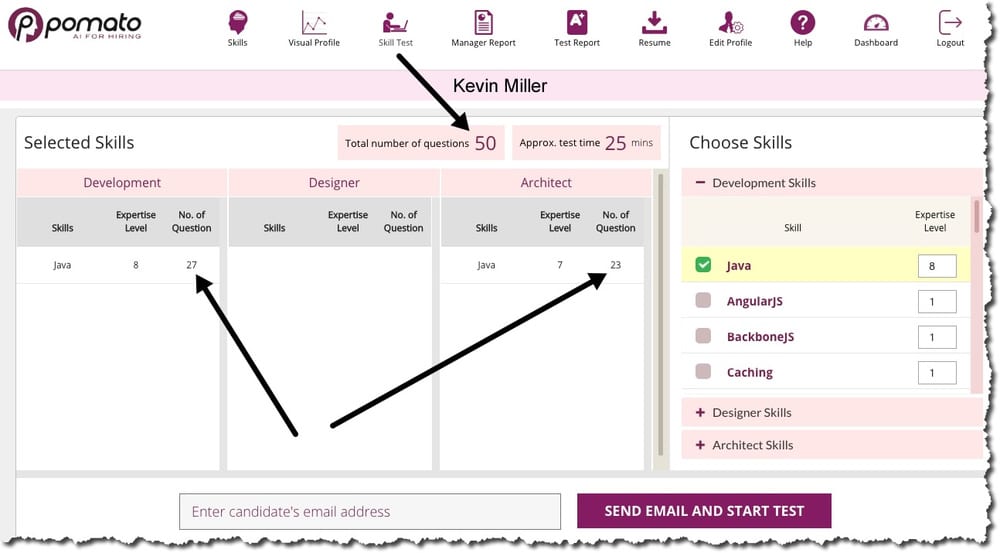

Pomato makes technical interviewing easier for nontechnical HR personnel. AI tools like Robot Vera, mentioned above, can help recruiters hire for more general roles.
2. Offer always-on onboarding.
Onboarding may be the most overlooked part of HR’s job. It’s certainly no less important, though. According to the Society for Human Resource Management research, great onboarding makes new hires 69 percent more likely to stay with a company for three years. What’s more, companies with a strong onboarding process boost new hires’ productivity by up to 50 percent.
With that said, onboarding is time-consuming. What’s a busy HR department to do? Turn to AI.
San Francisco-based Spoke offers a chatbot that answers workers’ most commonly asked questions. Companies that use Spoke can pre-load it with answers to the questions employees ask most often. After that, Spoke banks questions and answers from interactions that workers mark as successful.
Beyond answering questions, Spoke can help with a range of things that new hires are often unfamiliar with. It can manage room reservations and check out equipment. If an employee needs help with a tech process or tool, Spoke takes IT requests. When it can’t handle a request on its own, Spoke ropes in an office or HR manager.
3. Provide coaching and continuing education.
Another HR function that often gets short shrift? Employee education. Managers and HR personnel are trying to master their own roles. Unfortunately, that leaves little time to help workers with theirs.
Now, AI tools exist for both informal coaching and workplace-specific training.
PocketConfidant’s AI-powered chatbot helps users talk through their needs, wins, and goals. Through messaging tools like Slack, PocketConfidant encourages self-reflection and motivation through positive talk and intriguing questions.
For role training, consider EdCast. Billed as an “AI-powered knowledge cloud,” EdCast curates educational content. It pulls from a company’s learning management system, intranet, external providers, and subject matter experts.
Plus, Edcast also provides suggestions to team members within the systems they’re working in, such as Slack and Salesforce. For company leaders, EdCast offers a look at knowledge flows across the organization.
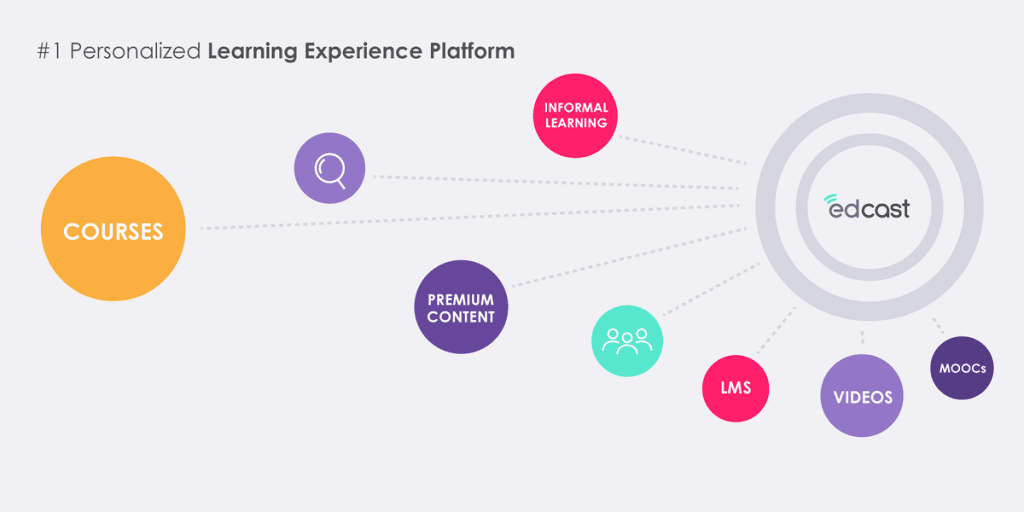

EdCast consolidates educational tools from across a company’s ecosystem into a single learning platform. Other AI tools, like PocketConfidant, offer informal coaching.
4. Ease compliance headaches.
Labor law violations are one of the costliest mistakes an HR team can make. Just last year, Instacart settled a class action lawsuit. The plaintiffs won $4.6 million for incorrect classification of workers as independent contractors. Cleaning startup Homejoy faced an even worse fate. It was forced to shut down after facing four such lawsuits.
AI tools can’t make classification choices for companies. They can, however, bring relevant statutes and laws to firms’ attention.
ComplianceHR, for instance, offers Navigator Suite. The system considers the whole picture of a work arrangement and shares ways to meet federal and state regulations. Navigator proactively gives advice about contractor classification, overtime eligibility, wage and hour issues, and leave-of-absence periods.
HR’s job may be managing human beings. But teams are discovering that real people don’t have to take on every task. Cutting or reducing the role of HR staff frees them up for “human required” work. AI can tackle tasks like résumé reviews or answering new hires’ questions. Humans still need to make choices like hiring decisions and career planning.
Five ways AI makes work life easier in 2023

There are plenty of AI tools on the market for HR, marketing, sales, and customer service. But what about all the small tasks in between that eat up business leaders’ time?
Can AI really make meetings more productive and scheduling less stressful? Even in its youth, AI can do that and much and more:
1. Track down wasted time.
The little things really do add up. That’s what AI startup Smarter Time is proving to its users. The Paris-based company is helping people squeeze extra hours out of their day. It shows them just how much time they spend commuting, checking Facebook, cooking, and doing other small tasks.
How, exactly, does Smarter Time do it? By analyzing data like device location, call details, calendar events, and app usage. After linking them to user inputs, the productivity tool assembles daily and weekly reports. It then offers helpful tips, such as encouraging a sleep-deprived user to hit the hay or reminding a lazy person to exercise.
2. Transcribe any conversation.
Meetings require a tricky balance between speaking, listening, and recording what’s said. During one, it’s easy to miss something critical like a deadline or a strategic shift. With Wrappup, however, users don’t have to choose. They can be present without struggling to take notes on the conversation.
Acquired this past April by Voicera, the Dubai-based startup takes speech-to-text technology another level.
First, it creates a searchable meeting transcript. It then recaps the discussion and even distributes meeting minutes to everyone. Plus, Wrappup works nicely with Voicera’s Eva assistant. Eva uses calendar integrations to take notes, even in meetings where the user isn’t present.
3. Plan trips and manage itineraries.
Traveling for work is never quite as fun as it sounds. Matching schedules and visiting clients is stressful. Adding to the stress are flights to find, hotels to book, taxis or Ubers to order, and meals to squeeze in.
Mezi, an AI startup recently acquired by American Express, makes the experience easier. Think of it as a pocket-sized travel agent. More than 60 percent of flights scheduled through Mezi are served by chatbots. Mezi also searches for hotels worldwide. It ranks options by cost, distance from meeting locations, and more. By making reservations in the user’s name, Mezi even ensures dinner meetings go off without a hitch.
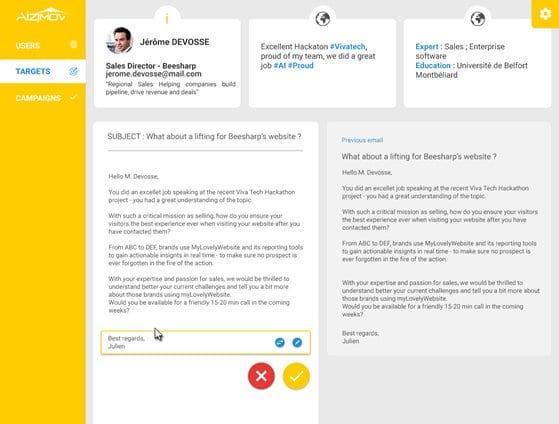

AI tool AiZimov makes up for a faulty memory by scraping recipients’ personal information from the internet and using it to personalize email messages.
4. Craft ideal emails.
Engaging emails share one thing in common: personalization. Tailored messages remind recipients that the sender is more than a business contact. But it’s not always easy to remember John’s hobbies or Jane’s children’s names.
The answer, according to French startup AiZimov? AI-based collection of the recipients’ online information and communication preferences.
AiZimov users only need to enter the recipient’s first and last name, email address, and associated company. The software then drafts an email that mentions, for example, a shared interest in film or other points of rapport.
What’s more, AiZimov gleans and incorporates the user’s tonality, message length, and favorite talking points. To avoid misunderstandings, AiZimov gives the sender a chance to review the email before shipping it. Although the tool isn’t free, its €99-per-month group plan is a small price to pay for better relationships.
5. Protect devices and data.
Another day, another data breach. Most everyone is aware of the need to protect their data. But the reality is that most of us put in little effort to actually do so. But in business, the stakes are higher. Frontier Secure is betting that business users are willing to pay $14.99 or so to pick up their data security slack.
Frontier Secure offers a little of everything to keep data and devices safe. Advanced tools detect spam and malware. Device protection provides up to $2,500 in coverage. Users enjoy a central management suite, phone support, and more. Plus, it includes automatic security patching.
For almost any task a business could come up with, an AI tool exists to make it easier. That’s not to say, however, that AI tools are plug-and-play. Whenever new technologies enter a workplace, there will be hiccups. What do companies need to overcome them? A smart, all-hands approach to adoption and integration.
What to expect when adopting AI.


AI technologies hold real promise. It’s no secret, though, that they also inspire confusion and fear.
Automation software provider Pega recently found that across 6,000 consumers in six countries, 72 percent are at least somewhat worried about AI. Among those who told Pega they were familiar with AI, 55 percent were comfortable with its business uses. Just 25 percent who weren’t familiar with it felt comfortable with its business applications.
Leaders adopting AI should expect to field the following questions and concerns:
1. “Our old system works fine. Do we really have to switch?”
Every organization has those who embrace change and those who fight it. The diffusion of innovation theory says that 16 percent of people are either innovators or early adopters. These people jump at the chance to try new technologies. About 68 percent will climb aboard once they’ve seen others successfully navigate the change. The remaining 16 percent will hold out against it.
Only about 16 out of 100 employees who will actually resist workplace AI.
To win these last few employees over, Wesleyan University lecturer Rebecca Knight cautions leaders not to punish workers. Rather, she suggests sharing why the new tools benefit both the company and its individual workers. She recommends building them into working routines as quickly as possible. Be sure to reward employees when they reach for new systems instead of old ones.
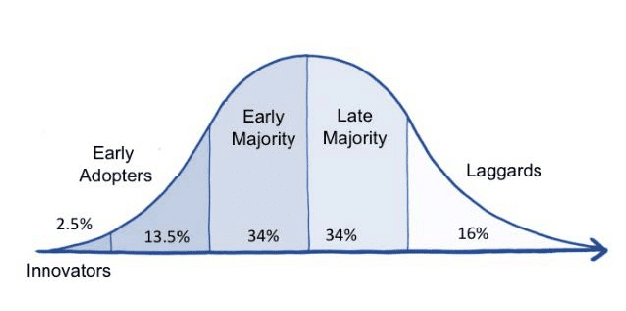

In his book “Diffusion of Innovations,” Everett Rogers proposed that the process by which a group adopts a new technology follows a bell curve. In workplaces, leaders should take special care to show laggards the benefits and ease of use of AI.
2. “Do we have the data we need to make it work?”
Workers who voice this concern have a valid point. Just 3 percent of companies’ data meets basic quality standards. Training on AI technology on data that is incomplete, inaccurate, outdated, or duplicated doesn’t work. The tool’s outputs tend to be equally poor. Feeding in third-party consumer data is especially risky. Many firms do so when they start from scratch with AI. But Deloitte claims that 71 percent of purchased data is inaccurate.
The degree to which companies should worry about data quality depends on two things:
First, the tools they choose. Second, how much machine training they plan to do themselves. Off-the-shelf AI assistants, for example, are already trained. They typically function just fine when hooked up to a calendar and email account. Specialized predictive analytics applications are another story. They’re unlikely to provide real insights if they aren’t trained on terabytes of relevant customer data.
Before investing more in AI, commission a data quality report.
Then, use a data quality tool to tackle issues that don’t require human intervention, such as duplicates and typos. Finally, task someone to comb through the data set. Check the tool’s work and resolve remaining errors. Cleaning up data may be costly. It’s cheaper than AI initiatives wrecked by bad inputs, though.
3. “We don’t know how to use these new tools.”
Gartner expects the business AI market to grow some 70 percent this year. But fewer than 3 percent of executives told Accenture that they expect to invest much more in the next three years to train workers to use AI tools. Too often, executives forget that technology investments must be followed by investments in the people who will use the new tools.
The issue, Accenture found, isn’t that workers don’t want to learn. More than two-thirds of those surveyed said they expected to learn new skills to work with AI in the next three to five years. Employers who want to succeed with AI must give workers adequate training. Whole-company, functional-group, and one-on-one sessions are necessary.
Managers, in particular, must be willing to answer mundane questions (“How do I use this interface?”). But they’ll also need to be prepared for moral and complex ones (“Would our customers want us to use their data in this way?” “How can we improve the accuracy of outputs?”).
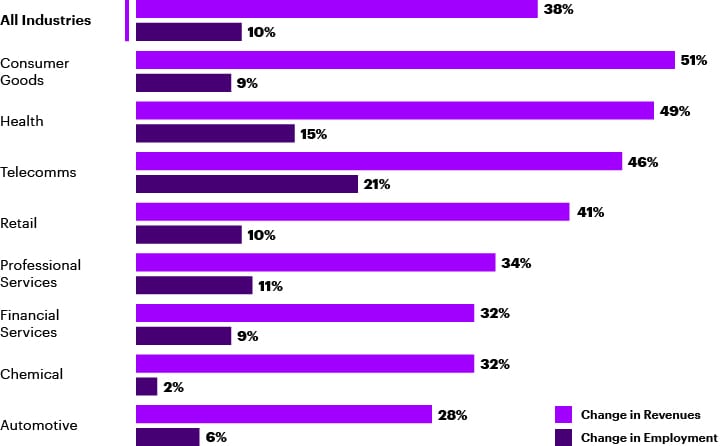

The Accenture report linked above found that if the average company were to invest as much in AI and training at the top-performing fifth of companies, it could grow its revenues by 28 to 51 percent.
4. “Will AI technologies work with the others we use?”
The AI market is still young. Many of its offerings are siloed. As competitors strike deals with one another, tools will work better together. In the meantime, leaders must make sure to choose those with APIs that play well with their existing tech stack. Integrations should be a particular concern with “hub” software like analytics platforms.
Not convinced of the importance of tool compatibility? Take the slightly more mature martech market.
Martech arrived on the scene in 2011, with roughly 150 tools. In 2018, it boasts nearly 7,000. These tools are both specialized and rapidly growing in number. No wonder the average enterprise uses 91 of them. According to a 2018 DemandLab survey, marketers cited integration as their top barrier to making effective use of marketing data. No other challenge came close.
5. “Are we going to be replaced by machines?”
Predictions about machines replacing people in the workplace have captured more than their share of media attention. Last December, for example, McKinsey published a “Jobs Lost, Jobs Gained” report. The study found that 30 percent of the U.S. workforce could be automated out of their roles by 2030. No wonder north of half of American workers worry about losing their jobs to machines.
The truth, however, is that employers who make the most of AI will use it to help their human workers.
Allstate, for instance, “hired” Amelia, an AI assistant, for its call center last year. While on calls, agents work side by side with Amelia. She provides tips and searches for needed documents. After Amelia’s first few months, Allstate found that her help cut average call time by nine percent. Amelia also reduced needs for follow-up calls by about one-fourth. Allstate’s service people are now able to take more calls with less stress.
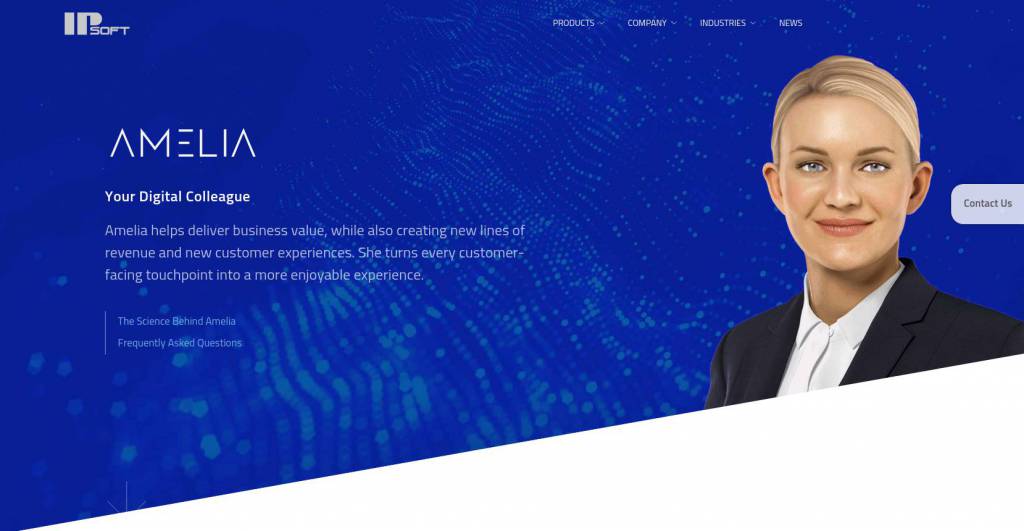

Amelia, built by IPsoft, guides customer interactions and looks up data. In a poll of agents working with Amelia, Allstate found 99 percent were “completely satisfied.”
Share stories like Allstate’s Amelia with skeptical workers. Remind them that past technological revolutions had their critics, too.
But each time, workers weren’t eliminated. They simply started doing different kinds of work. During the American Industrial Revolution, for instance, workers moved from factories to farms. Overall employment actually increased. So did workers’ standard of living.
Executives must listen to employees’ concerns. They should also remember, though, workers will adjust to the “new normal.” Expect the process to be similar to when digitization and globalization came to workplaces.
Danger or dream come true? Predicting the future of business AI.
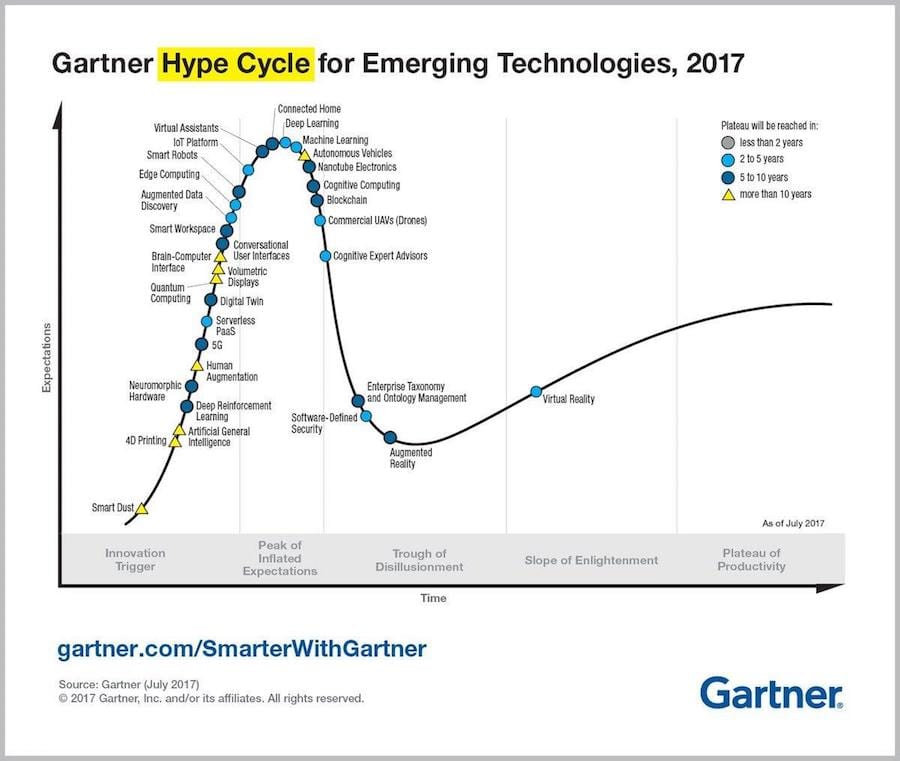

Gartner’s hype cycle plots how nascent technologies are viewed and adopted by the business community. Its 2018 report finds expectations around AI are at or near their peak
Each August, Gartner releases a report tracking the growth of a series of popular technologies. Gartner’s latest hype cycle report includes popular AI applications. Deep neural networks, virtual assistants, and mobile robots are all clustered around the “peak of inflated expectations.”
In the short term, leaders will likely pull back on their high hopes for AI. But doesn’t mean AI tools have no future in business.
After a slide into the “trough of disillusionment,” AI tools will ascend the “slope of enlightenment.” They’ll eventually crest to what Gartner calls a plateau of productivity. Depending on the application, Gartner guesses most AI applications will plateau in two to 10 years.
In the next decade, what should business users expect from the AI market?
1. Integrations will grow as leaders emerge.
As any tech matures, the market consolidates. Smaller providers are inevitably acquired or bested by their larger competitors. Consider what has happened since the martech tools debuted in 2010, for example. Each year, the sector saw a growing number of mergers and acquisitions. Once the pecking order is established, the winners move quickly to snap up the best ideas and talent. They then combine tools into suites that function cleanly together.
Because AI holds so much promise, tech leaders like Apple and Microsoft have pounced on it. But they’re not just building out their own systems.
They’re also racing to acquire startups in the space. Even so, the number of small AI startups is likely to shrink as the market grows. When that happens, companies should see tools improve. They’ll become easier to integrate, more effective together, and more similar in their interfaces.
2. Employees will expect to work alongside AI.
At present, employees feel afraid or skittish about working with automated systems. Last November, global consultant Genpact released a report showing that just 13 percent of U.S. workers say they’d feel “very comfortable” working alongside robots. Just 27 percent said they’d feel “fairly comfortable.”
True, 40 percent isn’t an inspiring number. But watch that figure tick upward as AI becomes a business staple. Take, for example, workplace use of computers. “Computerphobia” ran wild in the 1980s and early ‘90s. Sufferers were said to experience “a range of resistances, fears, anxieties, and hostilities.”
Computers are now so common that the U.S. National Center for Education Statistics stopped tracking business computer use back in 2003. Someone who suggested today that he was afraid of working with computers would likely be out of a job.

In discussing working with AI, respondents to a Genpact study believe the ability to change, as well as the ability to think critically, will become more important than technical expertise. At present, however, few employees say they’d be comfortable with robotic colleagues.
3. AI will lose its power as a selling point.
Design and development firm Yeti made waves back in 2016 by stating that the Internet of Things would be obsolete by 2020. Yeti, of course, didn’t mean that IoT technologies would no longer exist. Rather, it predicted that software and hardware integrations would become the table stakes for most consumer firms.
Fast forward to 2018, and it looks like Yeti’s prediction is coming true. Not once does “internet of things” appear on Amazon’s list of Alexa – and Echo-enabled products. Instead, Amazon simply describes what the products can do for their users.
In both the B2B and consumer markets, expect buzzwords to disappear from AI product pages.
Much like they do with IoT products, marketers will turn to functions and features to sell AI tools. A product “that uses deep learning to distill customer insights,” for example, may soon switch to plainer language. Think something like, “predict your next customer.”
4. General AI may — or may not — materialize.
Gartner predicts that artificial general intelligence is still more than 10 years from its peak of productivity. But the truth is, there’s little agreement in the scientific community as to when it might emerge. The editors of engineering magazine IEEE Spectrum recently asked a panel of experts to weigh in. Answers ranged from “soon” to “by 2029.” Some said, “hundreds of years away.”
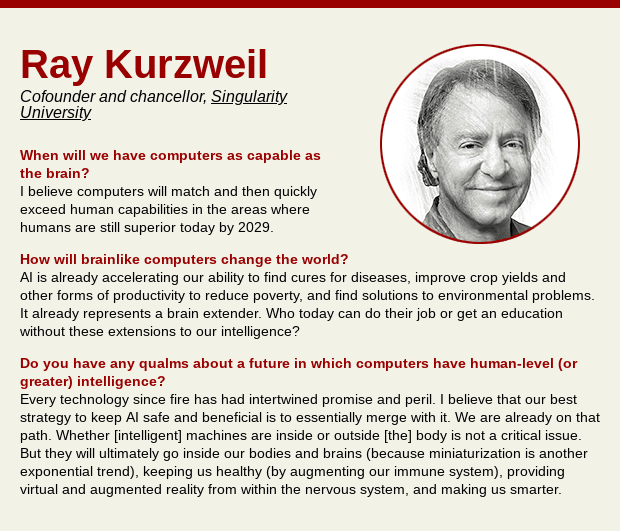

AI researcher and author Ray Kurzweil believes AI will exceed human capabilities in the next decade. Other experts told IEEE Spectrum that they were significantly less optimistic.
Why can’t experts seem to agree on general AI’s timeline? Because the evidence is conflicting and murky.
Jürgen Schmidhuber, scientific director of Swiss AI lab IDSIA, pointed out to Spectrum that computing has consistently become cheaper by tenfold every five years. Others, like Ruchir Puri, chief architect of IBM’s Watson, argue that machines will struggle with “human” abilities. Traits like innovation, empathy, and sharing might not be part of machines for a long time.
AI is here to stay.
One thing AI experts can agree on? Narrow uses of AI will become ever more popular, inexpensive, and powerful. In its latest hype cycle report, Gartner called this the coming “democratization” of AI. AI tools will become standard in every industry, at companies of every size, and across the global economy.
Currently worth about $4 trillion, the AI market is expected to explode.
By 2030, it will add somewhere around $13 trillion to the global economy, according to McKinsey Global Institute. If McKinsey is correct, AI should grow world GDP by about 1.2 percent per year. That’s four times greater than the steam engine’s boost to productivity in the late 19th and early 20th centuries.
What does that mean? It means those who call AI a fad or say it will end the world could not be more wrong. AI will remake the world in ways far greater than any technology before or perhaps even after it. Most of all, it means that business leaders who haven’t yet embraced AI had better get started in 2023.
What about Chat GPT?
Chat GPT was recently released and the world has been talking abut it ever since. Chat GPT is able to scour the internet and give more specific answers than Google. Chat GPT can help with SEO, coding, and automation of various tasks.
Updated February 3, 2023


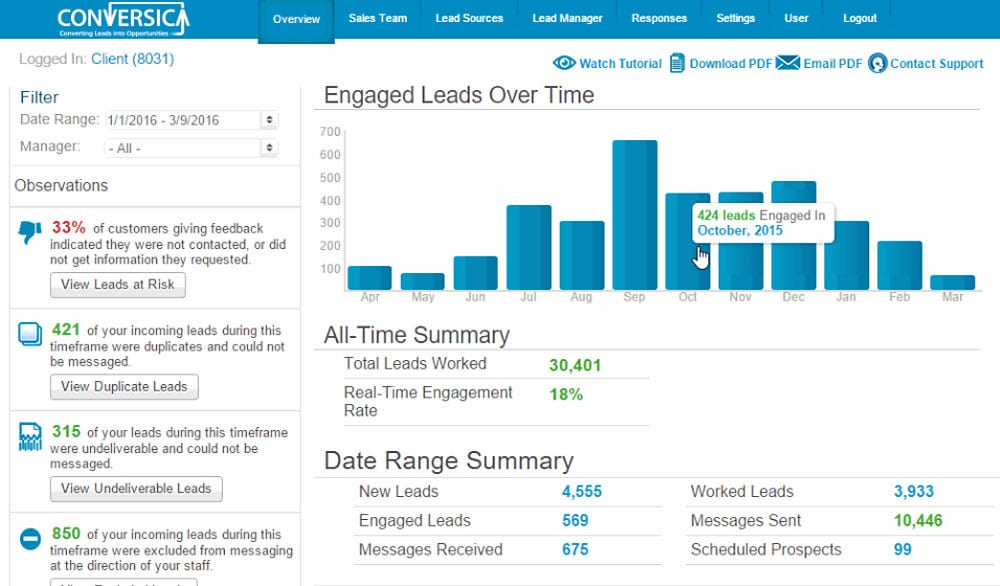
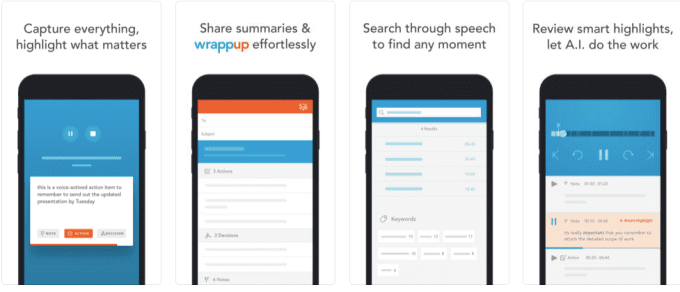
John Rampton
John’s goal in life is to make people’s lives much more productive. Upping productivity allows us to spend more time doing the things we enjoy most. John was recently recognized by Entrepreneur Magazine as being one of the top marketers in the World. John is co-founder and CEO of Calendar.